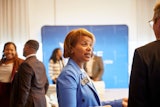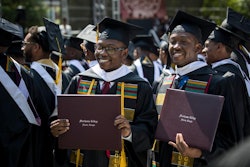After a little more than a year as its executive director, Dr. Leonard L. Haynes III has been credited with substantially improving the performance of the White House Initiative on Historically Black Colleges and Universities. Haynes, a veteran education department official and a former acting president of Grambling State University, took over the office in October 2007 after its previous executive director resigned under fire from the initiative’s board of advisors over performance.
Established in 1980 by former President Jimmy Carter, the White House Initiative was authorized by Executive Order and each president since has reauthorized it. Diverse caught up with Haynes and spoke to him about new programs and prospects for the White House Initiative, which coordinates federal involvement with the nation’s 105 HBCUs.
Here is some of what Haynes had to say:
How do you assess your tenure at the White House Initiative on Historically Black Colleges and Universities?
I think we’ve made tremendous progress since I’ve been the executive director. There’s no question about it. The excitement that’s been generated about what’s possible in this office has become more of a reality than just a dream.
And I’ll just go back to a moment that took place in February earlier this year when we had an event at the White House and the President of the United States celebrated Black History Month. I was there and much to my pleasant surprise (President Bush) recognized me out of all these people. And he pointed out the important work that was going on at the White House Initiative on HBCUs.
What steps were taken to get the initiative seen positively by Black college leaders?
I think one of the things we had to do was restore some credibility to this office because prior to my coming, there were some issues that were quite public. And I said to myself we can settle things down. Number one, we got to have a good relationship with the board of advisors, and that board is chaired by Dr. (Louis) Sullivan, a former secretary of Health and Human Services. So we repaired that relationship right away. I’ve known Lou for a long time, and he’s known me, so I told him that one of the things that we will do is make results happen. And I think that’s what the Secretary was after when she made this change.
What specific programs have you established?
Under the Executive Order, we have a wide reach, if you will, because we work with 32 federal agencies and one of the things I put back into place was the technical assistance conference. That hadn’t happened in a long time so we went to Norfolk State. I planned for 125 people to come; by God, 420 people came, exceeding our expectations.
It was a tremendous success so much so that we’re having our second technical assistance conference planned for March (2009) at Norfolk State again, and we anticipate that we’ll have about 500 attendees. We brought together members of the HBCU community, members of the business community, as well as the federal agencies, and that was great. Out of that came an announcement from the Department of the Navy to engage in a more constructive relationship with Norfolk State, as well as the announcement of a $1 million scholarship fund for HBCU students in the STEM (science, technology, engineering and math) fields.
The other thing we’ve done is that we’ve started an orientation for new college presidents of Black colleges. It’s never ever happened before. It dawned on me when I was talking to some presidents that a number of them were new, and they were asking some basic questions that I thought they had the answers to, but they didn’t.
I said we’re going to put together an orientation of federal programs for these new presidents. We had our first one on May 29 that was hosted by the University of the District of Columbia; we had some 15 presidents and chancellors come. Our initial focus was on Department of Education programs because they are so critical to the institutions — Title III, Title IV, and the HBCU Capital Finance Program.
I’m pleased to report that part two was held (in November) at the University of the District of Columbia. We did part two, and we expanded it. We went beyond the Education Department; we had the Department of Energy there, and the Department of the Navy came, as well as the Office of Personnel Management. I think now we will institutionalize this. A program with FEMA is another initiative that we’ve launched.
Another important initiative has been going on at NASA. NASA has this 1 percent goal to get HBCUs engaged and the concern is, will the agency be able to do so? We’ve been talking with NASA as well as with the members of the defense contracting industry — Lockheed-Martin, Boeing and the like — to try to see what can we do to come up with a strategy that will allow the HBCUs to take better advantage of the 1 percent NASA has out there.
The vice chair of the President’s Council on Financial Literacy, John Bryant, is engaged with us. We signed a memorandum of understanding with (the council) because he wants to help HBCU students be better informed as part of this financial literacy campaign. Of course, we’re in this economic crisis so this is right on time. Spelman College is already engaged so we have a model, and the plan is to add more institutions to that so we can get better information out to our students who are in need of this.
Can you talk about HBCU interaction with the U.S. Department of Health and Human Services?
Health and Human Services (HHS) is a huge agency, and we have a number of our institutions that are involved with HHS activities. We have three medical schools — Meharry, Morehouse, Howard; we have pharmacy schools; we have nursing programs; and we have schools of social work. And in meeting with the HHS people they said that they were not pleased with the kind of relationships that they have enjoyed with the HBCUs. There have been some success efforts, especially with the Office of Minority Health. But with the resources HHS has available, we’re not really playing in the sandbox we need to be playing in.
How do we correct that? (I asked myself.) In talking to Dr. Sullivan about this he said “Haynes, you’re absolutely right. I can speak to (this issue) as a former (HHS) Secretary. Let’s see what we can do to change this picture.”
We have in the offing now a meeting planned at Meharry Medical School on January 12, 2009 to invite the senior managers from HHS and to invite the appropriate HBCU decision makers to come to Nashville for a one-day discussion on what can be done to improve the relationship. That meeting will happen one day before the Presidents’ Board of Advisors will have its meeting at Fisk University.
How do you see the transition to the Obama Administration?
Looking at what I have seen about President-elect Obama, he has said one of his priorities will be increased support for HBCUs. That’s very encouraging; the (HBCU) community is very excited about that. With him saying that, I fully expect that he will also issue an Executive Order in support of HBCUs. There’s no reason for him not to because the Executive Order goes back to Jimmy Carter when the first order was signed and every President of the United States since President Carter has issued an Executive Order in support of HBCUs. I fully expect that will be the case with the President-elect.
Email the editor: [email protected]
Click here to post and read comments
© Copyright 2005 by DiverseEducation.com


















